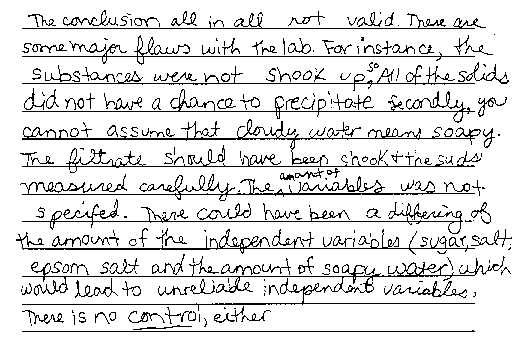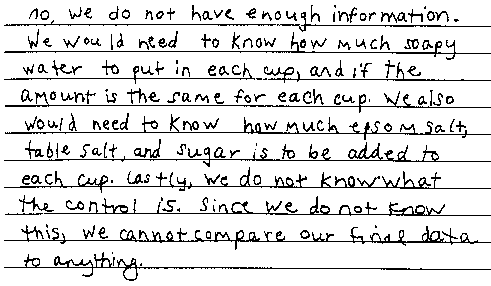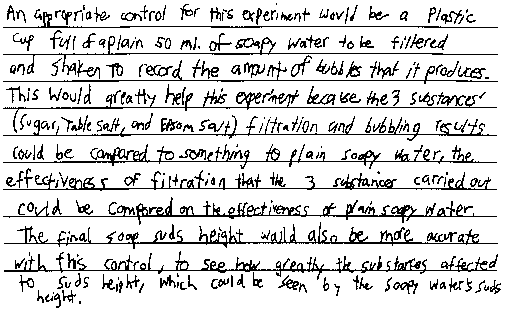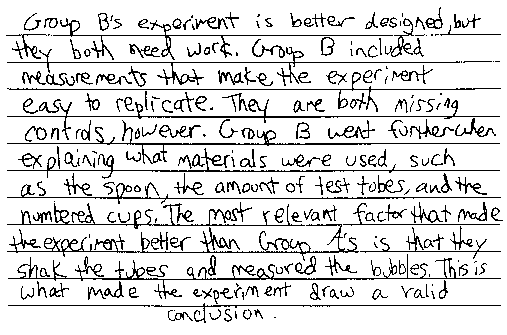Contributed by: Connecticut Academic Performance Test (CAPT)
There is one example for each score point ranging from 3 down to 0.
Explanations of the scores were written by staff from the Division
of Teaching and Learning at the Connecticut State Department of Education
who conducted training and scoring of field tested events.
Students in a science class were conducting experiments to explore
the use of various substances in removing soap from the water. One
way to remove soap from water is to have it react with other substances.
When the reactions occur, a solid called a precipitate is sometimes
formed. A precipitate can be filtered out of the water.
Group A carried out the following experiment.
- We put soapy water into three separate plastic cups.
- A different substance was added to each of the cups.
- After waiting five minutes, the mixture in each cup
was filtered.
- We examined the precipitate (which remained in the
filter paper) and the filtrate (which was in the test
tube) for each mixture.
|
The table below shows our results.
|
1 |
2 |
3 |
| Substance added to Soapy Water |
Epsom Salt |
Table Salt |
Sugar |
| Precipitate |
White, milky |
White, milky |
None |
| Filtrate |
Clear |
Slightly cloudy |
Cloudy |
Question 1 - Event Score = 3
Based on their results, Group A concluded that Epsom salt removed
the soap from the water. Is this a valid conclusion? Explain your
answer fully.

|
Component
|
Score
|
Commentary
|
|
Question 1
|
(3)
|
The response correctly questions the validity
of the conclusion.It explains that "you cannot assume that
cloudy water means soapy" and that "the filtrate should
have been shook and the suds measured carefully." The response
also points out that it is not clear if variables have been
controlled and that, "There is no control either." |
Question 2 - Event Score = 3
Do you have enough information to replicate Group A's experiment?
If you think so, explain what information you have. If you think not,
explain what other information you would need.

|
Component
|
Score
|
Commentary
|
|
Question 2
|
(3)
|
The response correctly states that there is not
enough information to replicate the experiment. It explains
that "how much soapy water" and "how much epsom
salt, table salt, and sugar" should be included in the
experiment. The response also explains that a control is missing.
|
Group B carried out the following experiment.
- We placed 50 mL of soapy water into three plastic cups.
- We added 10 grams of sugar to cup 1, 10 grams of table
salt to cup 2, and 10 grams of Epsom salt to cup 3. We
mixed each with a plastic spoon.
- We filtered all three mixtures.
- We then poured the filtrate (remaining liquid) into
3 separate test tubes, shook them and measured the height
of the soap suds.
|
The table below shows our results.
| Cup |
Substance |
Final Soap Suds Height |
| 1 |
Sugar |
9.1 cm |
| 2 |
Table Salt |
1.2 cm |
| 3 |
Epsom Salt |
0.2 cm |
Question 3 - Event Score = 3
Group B did not include a control in their experiment. What would
be an appropriate control? Explain your answer fully, including how
the control might improve the experiment.

|
Component
|
Score
|
Commentary
|
|
Question 3
|
(3)
|
The response is correct and well elaborated as
to what would make an appropriate control for the experiment.
It explains how the control would improve the experiment. |
Question 4 - Event Score = 3
Compare Group A's and Group B's experiments. Which experiment, if
either, is better designed? Explain your answer fully.

|
Component
|
Score
|
Commentary
|
|
Question 4
|
(3)
|
The response discusses several factors pertaining
to the quality of the experimental designs ("Group B
included measurements", "both missing controls",
"The most relevant factor that made the experiment better
than Group A's is that they shook the tubes.") |
Go to Next Student Work
|
|





